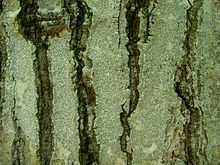Ostropomycetidae
| Ostropomycetidae | |
|---|---|

| |
| The lichen Graphis scripta, Jones County, Georgia, USA | |
| Scientific classification | |
| Domain: | Eukaryota |
| Kingdom: | Fungi |
| Division: | Ascomycota |
| Class: | Lecanoromycetes |
| Subclass: | Ostropomycetidae Reeb, Lutzoni, & Cl.Roux (2004) |
| Orders | |
The Ostropomycetidae are a subclass of mostly lichen-forming fungi in the class Lecanoromycetes. It contains nine orders and 37 families.[1]
Arctomiaceae is the only family in the Ostropomycetidae that associates with cyanobacteria of the order Nostocales as its main photobiont partner.[2]
Taxonomy
[edit]The subclass was circumscribed in 2004 by Catherine Reeb, François M. Lutzoni, and Claude Roux. This classification was based on molecular phylogenetics studies combining nuclear ribosomal RNA genes (SSU and LSU) with the protein-coding gene RPB2.[3]
The taxonomic framework is anchored by the type order Ostropales, which includes the type family Stictidaceae (synonymous with Ostropaceae) and its type genus Stictis. Phylogenetic analyses reveal that the Ostropomycetidae comprises two major evolutionary lineages: the Pertusariales-Icmadophilaceae clade and a group consisting of the Ostropales, Baeomycetales, and Hymeneliaceae.[3]
Description
[edit]The Ostropomycetidae are a subclass of fungi that can exist either as non-lichenised forms or as lichens with a variety of body types, including crust-like, scaly (squamulos), or filamentous thalli. When lichens are present, their photosynthetic partners (photobionts) are usually green algae of a simple, rounded shape (chlorococcoid) or algae of the genus Trentepohlia, known for their orangeish hue.[3]
The reproductive structures (ascomata) of these fungi can be found embedded in the lichen's surface (immersed), sitting on top of it (sessile), or raised on a stalk (pedunculate). They take the form of open, disc-like fruiting bodies known as apothecia—these can present in different styles, such as cryptolecanorine and lecanorine forms, and sometimes appear as lecideine when partially immersed. In some members, the reproductive structures may instead resemble flask-shaped perithecia.[3]
Inside the ascomata are special sac-like cells (asci), each typically holding eight or fewer spores (ascospores). These spores are colourless and can be simple (without internal divisions), divided by transverse walls, or arranged into more complex, brick-like partitions (muriform). Thin, thread-like supporting filaments called paraphyses may be simple or may branch and reconnect (anastomose), providing structural support and aiding in spore production.[3]
The asci can have one or two layers (unitunicate or bitunicate) but function as if they have a single layer. They may or may not contain a tholus (a structure in the ascus tip), and this tholus can sometimes react with iodine, making it appear bluish (amyloid). Additionally, some asci have an "ocular chamber"—a distinct region at the tip that helps release spores—while others do not.[3]
Taxa of uncertain classification
[edit]The following taxa are of uncertain classification (incertae sedis) in the Ostropomycetidae:[1]
Family incertae sedis:
- Epigloeaceae Zahlbr. (1903)
Genera incertae sedis:
- Amphorothecium P.M.McCarthy, Kantvilas & Elix (2001) – 1 sp.
- Anzina Scheid. (1982) – 1 sp.
- Aspilidea Hafellner (2001) – 1 sp.
- Bachmanniomyces D.Hawksw. (1981) – 8 spp.
- Dictyocatenulata Finley & E.F.Morris (1967) – 1 sp.
- Malvinia Döbbeler (2003) – 1 sp.
- Pleiopatella Rehm (1908) – 1 sp.
References
[edit]- ^ a b Hyde, K.D.; Noorabadi, M.T.; Thiyagaraja, V.; He, M.Q.; Johnston, P.R.; Wijesinghe, S.N.; et al. (2024). "The 2024 Outline of Fungi and fungus-like taxa". Mycosphere. 15 (1): 5260–5267. doi:10.5943/mycosphere/15/1/25. hdl:1854/LU-8660838.
- ^ Miadlikowska, Jolanta; Kauff, Frank; Högnabba, Filip; Oliver, Jeffrey C.; Molnár, Katalin; Fraker, Emily; et al. (2014). "A multigene phylogenetic synthesis for the class Lecanoromycetes (Ascomycota): 1307 fungi representing 1139 infrageneric taxa, 317 genera and 66 families". Molecular Phylogenetics and Evolution. 79: 132–168. doi:10.1016/j.ympev.2014.04.003. PMC 4185256. PMID 24747130.
- ^ a b c d e f Reeb, V.; Lutzoni, F.; Roux, C. (2004). "Multilocus phylogenetic circumscription of the lichen-forming fungi family Acarosporaceae and its position within the Ascomycota". Molecular Phylogenetics and Evolution. 32 (3): 1036–1060. doi:10.1016/j.ympev.2004.04.012. PMID 15288074.
